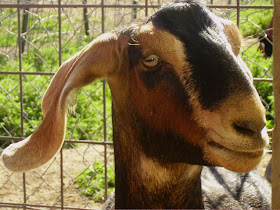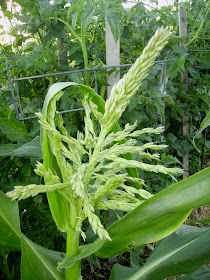
Are these the good guys or some more bad guys? Right now, I could use a bug Zorro or two to help fight the crime in my garden. Especially if they would drive off the flea beetles and grasshoppers as they are having a smorgasbord at my expense. These little critters were amongst a bunch of ladybugs on my spinach that has gone to seed. Please say they are members of the crime stoppers...

...because I know these are the bad guys. Look what they're doing to my potatoes...

...and my grape vines.

...and my poor broccoli that the flea beetles haven't found yet.

Speaking of Flea Beetles, here they are and there the broccoli plant won't be by tonight.

Isn't it bad enough that I have to deal with soil the likes of which creates Grand Canyons on a model size. This crack is six inches deep. The rancher who sold this piece of property to build our town on said he avoided this plot of land whenever possible and couldn't figure out why the coal mine wanted to place its workers here. I'm still trying to figure that out as I battle to readjust the soil each year as the clay resurfaces to starve the plants of air and compact their roots.
Unlike my father, who numerous times told me in an exasperating tone, "Your more stubborn than a mule.", I'm grateful for my tenacity since it is what has kept me going all these years climbing those steep hills of life. One of my trials has been gardening for twenty-eight years in this blasted soil. Compound the insect infestations and the weather which recently we suffered an intense drought for over seven years where the sage brush was dying and we joked that even the jackrabbits had to pack a lunch and it's a wonder I'm still gardening.
Thankfully, the weather is getting back to normal and I've vowed to not complain about having to walk in Prairie Heels (My name for the clay that packs under your shoe heel after a brief shower.) for the moisture renews the countryside for my bees and saves on our water bill.

So what am I doing to enable a garden to grow in this poor piece of land? I'm learning by experimenting. In the name of improving my soil, I accidentally made sod bricks instead - the same type the pioneers created to build their homes in this county many years ago. I added to the clay soil grass and a little old hay, but not nearly enough manure, and I had a dandy brick-garden size. I've even created cement. Unfortunately, my asparagus is still cemented in and I hope this fall to begin to build it a new home. Years back, I added lots of sand with some humus thinking I was doing them a big favor. Well, the clay reclaimed its territory over the years and moved upward combining with the sand and now it's going to take a good dousing of water and a pry bar to break the soil loose from around their roots. Think I'm joking? You'll be the first one I call to come help. It is a near miracle that the asparagus surfaces at all. To find the stalks amongst the native grass, I have to hand trim the blades breaking them off at the ground's surface, for the grass can't be pulled.

I haul in two eighteen foot long by four foot high trailer loads of manure every two or three years and in between a number of pickup loads. It is not enough but it is all I every other disc bulging and a fusion on the bottom can handle. Because we don't have a tractor and I'm not able to haul more manure our vegetables are planted as close as possible to each other. I'm not leaving any empty space and very few walking paths.

This has the advantage that soon the plants are big enough to choke out the weeds because there isn't any extra space for them to grow in. Little evaporation takes place since the plants shade the ground and I don't have to water as often - a big factor when the average rainfall in Wyoming is only thirteen inches a year and the cost of water isn't cheap.

With rows so close together, I only use a normal size hoe at the beginning of the year then I switch to a sugar beet hoe that's small and allows me to work in a confined space.
My six foot two son hates the plan because I, with my size eight shoes, have to tip toe while carefully plotting where to place my feet then twist and contort to pick the vegetables. He complains his size twelve shoes don't fit and I tell him to just think of it as a game. You remember Twister? I loved that game but he's not impressed with my garden version.
Every year, my garden gets a little better as I rototil it only once so as not to disturb the micro organisms and the worms who's excrement is magical and all of our animals contribute except our fourteen year old cat, but that's another story.

Our pigs( if they're in residency) and our chickens have become our garbage disposal for all our vegetable scraps and the meat scraps go to the barn cats. In the spring and summer, I feed weeds from around their coop to the chickens and garden extras like the runaway lettuce or zucchini the neighbors have had their fill of. I even plant Swiss chard just for the chickens because it handles frost well and I can feed it way in to the fall. The chicken's poop and their egg shells (which I grind up in the blender with plenty of water) are spread onto the garden to give it a boost of nitrogen and calcium.
The sawdust from the goats shed, beef shed, and pig shed is an essential ingredient as it shrinks and swells keeping the soil broke up. The animal manure which is high in nitrogen is needed to break it down and if not enough is available the plants will suffer. Hence, I add lots of old manure. The sawdust also raises the pH level of our soil but not enough so I have to add some sulfur fertilizer. If I put a deeper layer of sawdust I would off balance the needs of the plants for nitrogen. Remember that manure should be aged at least three months before being added to a garden. Mine is at least a year old except that which is mixed in the sawdust.
 Sophie (the pig) thinks being helpful feels really good especially when it involves a nap
Sophie (the pig) thinks being helpful feels really good especially when it involves a nap.
 Who me, I'm helpful? Chicory seems to say and she's right, she isn't often helpful but goat dingleberries ( poop) are an excellent addition to the garden, so is cow manure
Who me, I'm helpful? Chicory seems to say and she's right, she isn't often helpful but goat dingleberries ( poop) are an excellent addition to the garden, so is cow manure.
 Tinker Bell, our yearling heifer, even contributes to the garden when on the rare occasion she tears up fence
Tinker Bell, our yearling heifer, even contributes to the garden when on the rare occasion she tears up fence.
The cow panels which are four feet by sixteen feet work great when down sized and the damaged areas snipped out with a pair of bolt cutters as a cutting torch takes too long. Then, we build tomato cages, or trellises for the peas, or concord grapes.
 Peas with tomatoes in the background.
Peas with tomatoes in the background.Don't worry if the cow panels are a bit bent. A straight row doesn't make your plants grown any better. Just don't make the pea trellis too tall. I used a section from last years experiment to train cucumber to climb and it doesn't straddle well when I'm weeding.

Baling twine from your already consumed hay bales works great for marking the rows to plant. We use small square bales so I fasten several pieces together. Just tie a knot by the stake that can be loosened because the twine stretches a bit and will need re-tightened. Don't forget those pole beans as they can trail up the twine and save on your having to purchase string.

When I clean out the old hay that litters the hay shed floor, I put it around the potatoes for mulch to discourage weeds and retain moisture. I also use my lawn clippings for mulch and spread the summers supply of sawdust from the sheds around the beets and beans.

I almost forgot to show you the army I hired to help me eradicate bugs. I brought home six pullets from the corrals and built a shed from scrap plywood for them. They're rather shy and wouldn't come out from behind the asparagus plants for two days unless, I was out in the garden. Then, they would scatter around especially in the youngest pea and bean rows looking for bugs. Not that they were more plentiful there but maybe, they, like me, feel more comfortable in the wide open spaces.
 Australorps chasing bugs
Australorps chasing bugsWith each day that passes the chickens adventure further into the garden and the grasshoppers are starting to take flight. So far, no damage to my garden crops from the chickens.
I was surprised to learn that the pullets had imprinted on me as they do tend to follow me around. When I call, "Here chick, chick, chick.", I'm ignored. But, if I holler, "Come on girls." they come sauntering over. Now go figure that one out.
(Correction in Lessons Learned I said our garden was too low a pH and I added sulfur well I changed the blog because I meant too high a pH and I add sulfur to acidify it. Sorry for the mistaken bleep.) For some reason in my head high acid means high pH.

 I took this picture to emphasize my point. That is tomatoes behind the volunteer corn stalk. The seed brand touts that it is a good cold emergence species. That looked pretty good to me when I ordered a pound from the seed company and it did well last year passing in height my five foot seven inch frame. But obviously, emerges well in cold soil and grows well chilled are not synonymous.
I took this picture to emphasize my point. That is tomatoes behind the volunteer corn stalk. The seed brand touts that it is a good cold emergence species. That looked pretty good to me when I ordered a pound from the seed company and it did well last year passing in height my five foot seven inch frame. But obviously, emerges well in cold soil and grows well chilled are not synonymous.






















































